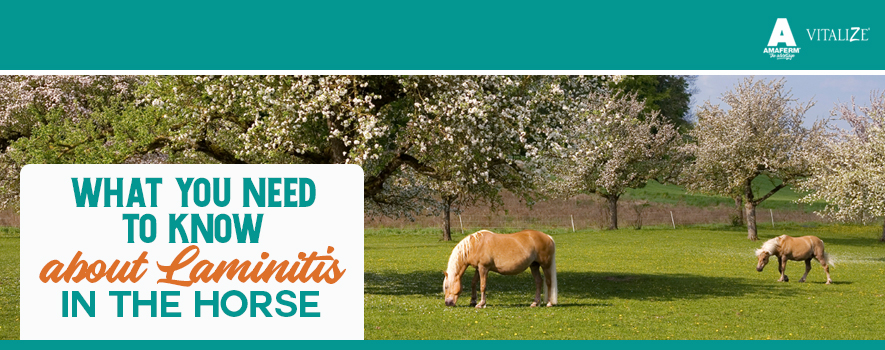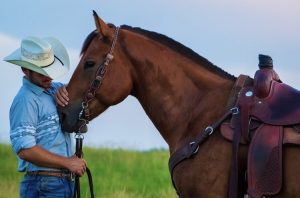
 With the beginning of spring comes warmer weather, green grass, and as any horse owner knows… laminitis. What is laminitis? Laminitis, also known as “founder,” is the inflammation of the laminae – or the soft tissue that attaches the coffin bone of the foot to the hoof wall. When that tissue is inflamed, it becomes more fragile and easily manipulated, and the deep digital flexor tendon, located near the back of the leg, will begin to pull the coffin bone down and back, sometimes called “sinking” or “rotation.” In severe cases, it can cause the coffin bone to be pushed through the bottom of the hoof. Due to the horse’s conformation forcing 60% of its weight on the forehand, laminitis is generally found in the front feet, however it can occur in any given hoof, depending on the circumstances.
With the beginning of spring comes warmer weather, green grass, and as any horse owner knows… laminitis. What is laminitis? Laminitis, also known as “founder,” is the inflammation of the laminae – or the soft tissue that attaches the coffin bone of the foot to the hoof wall. When that tissue is inflamed, it becomes more fragile and easily manipulated, and the deep digital flexor tendon, located near the back of the leg, will begin to pull the coffin bone down and back, sometimes called “sinking” or “rotation.” In severe cases, it can cause the coffin bone to be pushed through the bottom of the hoof. Due to the horse’s conformation forcing 60% of its weight on the forehand, laminitis is generally found in the front feet, however it can occur in any given hoof, depending on the circumstances.
The Causes of Laminitis
A common cause of laminitis is overconsumption of starch or lush forage, like when a horse breaks into the feed room and eats half of a bag of grain, or when one is left out on pasture for too long in the spring, before its body can adjust to the new, nutrient-filled grass. This is why it is important to introduce changes to the diet gradually and not overwhelm the stomach and digestive system. As mentioned in our previous blog, Think Outside the Gut: How Digestion Affects Your Horse’s Overall Health, the horse’s stomach is only the size of a football. Can you imagine? (The next time you go mix feed, think about that!) With that in mind, it is easy to understand that when we feed our animals large amounts of concentrated grain, things might not always go as planned.
Let’s break it down a bit further: when you feed your horse too much grain, undigested starches can get pushed into the hindgut where they are fermented by a particular type of gut microbe that produces lactic acid. From here, the pH of the hindgut decreases due to the lactic acid, the good fiber-loving bacteria start to die off, and, as they die, endotoxins are released. These conditions cause the integrity of the gut to often be compromised, meaning those endotoxins are now able to enter the bloodstream. From this, comes laminitis.
Another cause of laminitis can occur after injury of a limb, when a horse must put more pressure than usual on an adjacent limb. This puts an overwhelming amount of stress on the non-injured leg and can set your horse into a laminitis spell. This is why when a horse breaks a leg, in recovery he will be suspended from the ceiling to avoid the weight. Improper farrier work can also bring on the onset of laminitis, so choose wisely.
Which Horses are at risk for Laminitis?
Your horse might be at risk if he or she is:
- overweight and/or “cresty”
- has Cushing’s disease
- has insulin resistance
- consumes large amounts of nonstructural carbohydrates
- has access to newly lush forage for long periods of time
- has foundered previously
- has recently had an injury to a limb
- has recently had a negative farrier experience
Common Symptoms of Laminitis
 How do I know if my horse has laminitis? If your horse does not fall into the above categories, it is still something to know and observe in the barn. Here are some common signs:
How do I know if my horse has laminitis? If your horse does not fall into the above categories, it is still something to know and observe in the barn. Here are some common signs:
- Leaning back on hind legs to relieve pain off of front-end
- A strong digital pulse
- Short, shuffling or uncomfortable gait
- Hot hoof
- Increased heart rate and temperature
If your horse shows these signs, call your vet immediately! If not taken care of right away, laminitis can be life-threatening. While waiting for your vet, soak your horse’s front hooves in ice or cold water to help decrease the blood flow to the area.
How to Prevent Laminitis
The first thing to do if you have a laminitis-prone horse is make sure his or her diet is consistent and in line with his or her lifestyle. For example, if you have a fat pasture ornament that never gets worked, he or she does not need to be eating a large amount of grain. Also, try to avoid allowing overconsumption of lush grass in the spring, especially after a cool night.
In conclusion, laminitis is a condition directly related to the horse’s diet and can be prevented with the correct management. Know if your horse is at risk and keep any changes to its diet or lifestyle to a minimum. If you fear your horse could be suffering from the early onset of laminitis, contact your veterinarian right away. Additionally, administering Vitalize® Equine Gel can help relieve stomach discomfort and reduce the bad microbes in the gut that can lead to laminitis. Lastly, work closely with your veterinarian to assure your horse is getting off on the right foot this spring.

